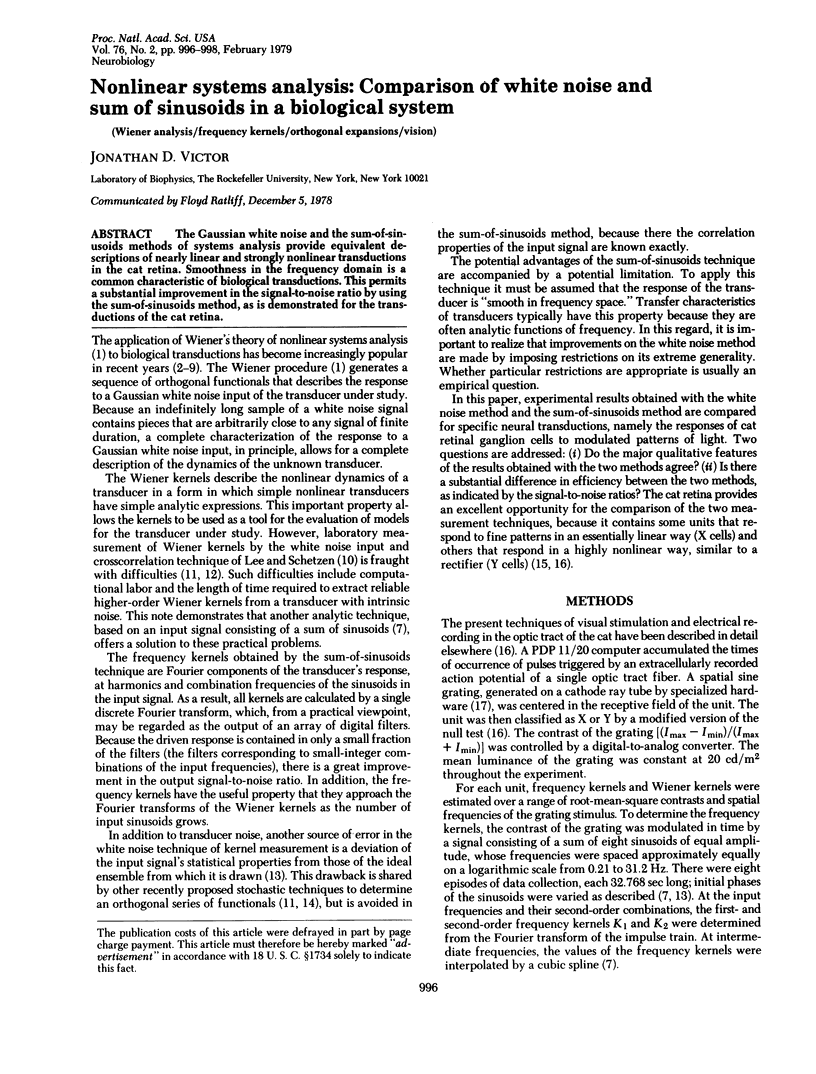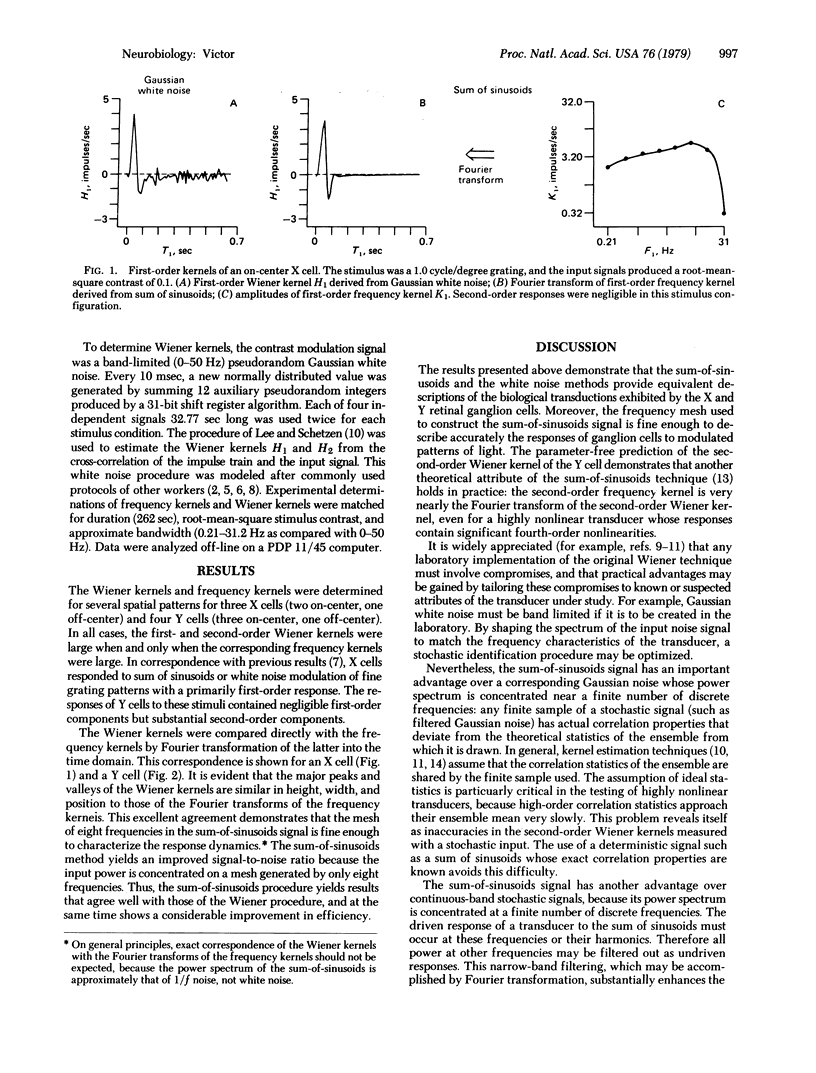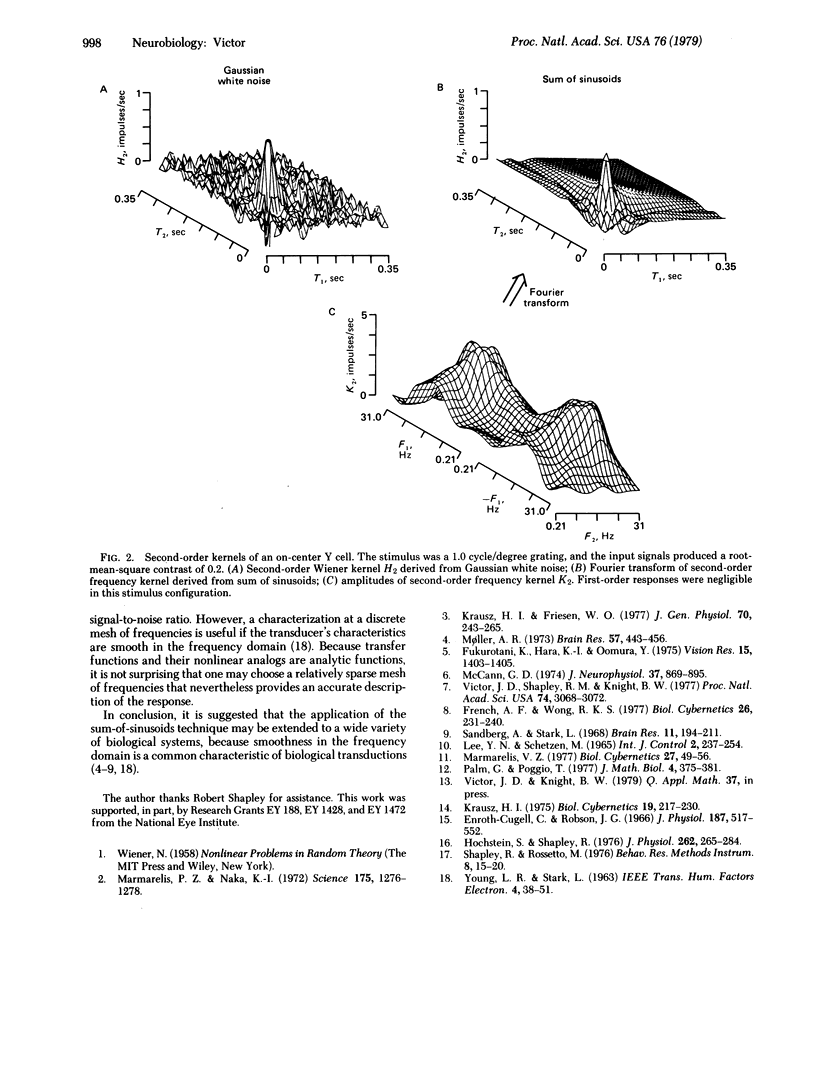Abstract
The Gaussian white noise and the sum-of-sinusoids methods of systems analysis provide equivalent descriptions of nearly linear and strongly nonlinear transductions in the cat retina. Smoothness in the frequency domain is a common characteristic of biological transductions. This permits a substantial improvement in the signal-to-noise ratio by using the sum-of-sinusoids method, as is demonstrated for the transductions of the cat retina.
Full text
PDF


Selected References
These references are in PubMed. This may not be the complete list of references from this article.
- Enroth-Cugell C., Robson J. G. The contrast sensitivity of retinal ganglion cells of the cat. J Physiol. 1966 Dec;187(3):517–552. doi: 10.1113/jphysiol.1966.sp008107. [DOI] [PMC free article] [PubMed] [Google Scholar]
- French A. S., Wong R. K. Nonlinear analysis of sensory transduction in an insect mechanoreceptor. Biol Cybern. 1977 Jun 13;26(4):231–240. doi: 10.1007/BF00366595. [DOI] [PubMed] [Google Scholar]
- Fukurotani K., Hara K. I., Oomura Y. Dynamic characteristics of the receptive field of L-cells in the carp retina. Vision Res. 1975 Dec;15(12):1403–1405. doi: 10.1016/0042-6989(75)90198-4. [DOI] [PubMed] [Google Scholar]
- Hochstein S., Shapley R. M. Linear and nonlinear spatial subunits in Y cat retinal ganglion cells. J Physiol. 1976 Nov;262(2):265–284. doi: 10.1113/jphysiol.1976.sp011595. [DOI] [PMC free article] [PubMed] [Google Scholar]
- Krausz H. I., Friesen W. O. The analysis of nonlinear synaptic transmission. J Gen Physiol. 1977 Aug;70(2):243–265. doi: 10.1085/jgp.70.2.243. [DOI] [PMC free article] [PubMed] [Google Scholar]
- Marmarelis P. Z., Naka K. White-noise analysis of a neuron chain: an application of the Wiener theory. Science. 1972 Mar 17;175(4027):1276–1278. doi: 10.1126/science.175.4027.1276. [DOI] [PubMed] [Google Scholar]
- Marmarelis V. Z. A family of quasi-white random signals and its optimal use in biological system identification. Part I: theory. Biol Cybern. 1977 Jul 8;27(1):49–56. doi: 10.1007/BF00357710. [DOI] [PubMed] [Google Scholar]
- McCann G. D. Nonlinear identification theory models for successive stages of visual nervous systems of flies. J Neurophysiol. 1974 Sep;37(5):869–895. doi: 10.1152/jn.1974.37.5.869. [DOI] [PubMed] [Google Scholar]
- Moller A. R. Statistical evaluation of the dynamic properties of cochlear nucleus units using stimuli modulated with pseudorandom noise. Brain Res. 1973 Jul 27;57(2):443–456. doi: 10.1016/0006-8993(73)90148-0. [DOI] [PubMed] [Google Scholar]
- Palm G., Poggio T. Wiener-like system identification in physiology. J Math Biol. 1977 Oct 20;4(4):375–381. doi: 10.1007/BF00275085. [DOI] [PubMed] [Google Scholar]
- Sandberg A., Stark L. Wiener G-function analysis as an approach to non-linear characteristics of human pupil light reflex. Brain Res. 1968 Oct;11(1):194–211. doi: 10.1016/0006-8993(68)90081-4. [DOI] [PubMed] [Google Scholar]
- Victor J. D., Shapley R. M., Knight B. W. Nonlinear analysis of cat retinal ganglion cells in the frequency domain. Proc Natl Acad Sci U S A. 1977 Jul;74(7):3068–3072. doi: 10.1073/pnas.74.7.3068. [DOI] [PMC free article] [PubMed] [Google Scholar]


